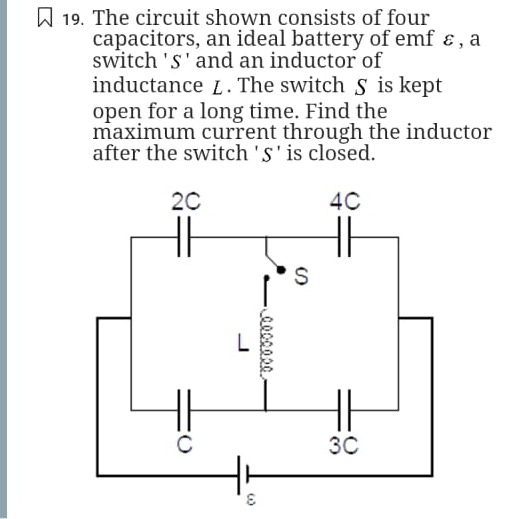Question
Question: The circuit shown consists of four capacitors, an ideal battery of emf $\mathcal{E}$, a switch 'S' a...
The circuit shown consists of four capacitors, an ideal battery of emf E, a switch 'S' and an inductor of inductance L. The switch S is kept open for a long time. Find the maximum current through the inductor after the switch 'S' is closed.

Imax=ϵ3L4C
Solution
We first note that only the top‐branch capacitors (of capacitances 2C and 4C) are in the branch with the inductor. Since they are in series, their equivalent capacitance is
Ctop=2C+4C(2C)(4C)=6C8C2=34C.For a long time before closing the switch, the top‐branch capacitors are uncharged while the bottom branch (with capacitors C and 3C in series) is charged by the battery. After closing the switch the circuit becomes a “forced LC” system. In the top branch the loop equation (taking the battery emf ϵ into account) is
ϵ−vC−vL=0,where the voltage across the capacitor network is
vC=Ctopqand the inductor voltage is vL=Ldt2d2q (with i=dtdq). Thus we have
Ldt2d2q+Ctopq=ϵ.This is the equation of a harmonic oscillator with a forcing term and equilibrium charge q0=Ctopϵ. With the initial conditions (at t=0 the charge q(0)=0 and current i(0)=0), one finds that
q(t)=Ctopϵ(1−cos(ωt))with
ω=LCtop1.Thus, the current in the inductor is
i(t)=dtdq=Ctopϵωsin(ωt).Its maximum value occurs when sin(ωt)=1, hence
Imax=Ctopϵω=ϵCtopLCtop1=ϵLCtop.Substitute Ctop=34C to obtain
Imax=ϵ3L4C.Summary:
- Find the equivalent capacitance of the top branch: Ctop=34C.
- Write the LC loop equation using q/Ctop as the capacitor voltage and L(d2q/dt2) for the inductor.
- Solve the forced harmonic oscillator with equilibrium charge q0=Ctopϵ.
- The current amplitude is Imax=Ctopϵω=ϵCtop/L and substituting Ctop gives the answer.
